Events
Can the “Fantasia” Blu-ray help raise the Walt Disney Family Museum ‘s profile?

Well, it looks like Christmas is coming a little early not only for fans of Walt Disney the man, but also for the Walt Disney Family Museum at The Presidio in San Francisco.
Today, Walt Disney Studios Home Entertainment is releasing a combo Blu-ray / DVD collection featuring both "Fantasia" and "Fantasia 2000."
And if that wasn't reason enough to celebrate – both films look marvelous in high-definition Blu-ray and sound superb – the company is also releasing on Blu-ray / DVD "The Sorcerer's Apprentice," inspired by a segment from "Fantasia," and DVDs of three recent Disney-related documentaries: "the boys: the sherman brothers' story," "Waking Sleeping Beauty" and "Walt & El Grupo."
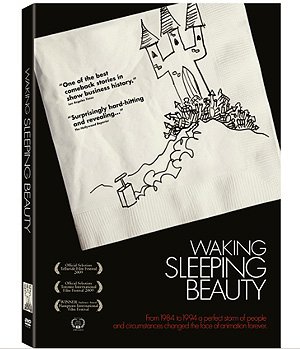
Copyright Disney Enterprises, Inc. All rights reserved
There's plenty of choices there for any Disney fan's holiday wish list.
To celebrate the release of "Fantasia / Fantasia 2000," the company flew dozens of media professionals from around the world to San Francisco a few weeks ago and gave them a quick tour of the Walt Disney Family Museum and a chance to talk with Diane Disney Miller and her son, Walter E.D. Miller.
Diane, Walter and founding director Richard Benefield are featured in a 5-minute bonus segment on both the DVD and Blu-ray "Fantasia" discs talking about the museum. The Blu-ray disc also offers a 14-minute look at one of the museum's prized possessions, the Schultheis Notebook, and the man who created it.
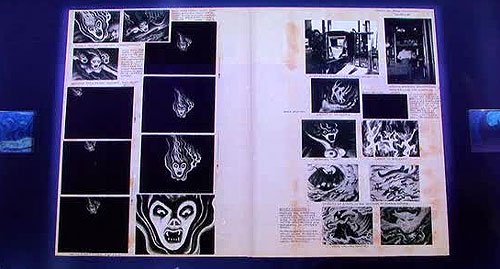
Copyright The Walt Disney Family Museum. All rights reserved
Throughout the development of the animated masterpiece "Fantasia," a member of Disney's camera effects department – Herman Schultheis – kept a detailed record of the work he and others pioneered long before the age of CGI. His notebook is filled with drawings, behind-the-scenes photographs, frames of film, charts and written descriptions that reveal many of the techniques that were used in early Disney films.
Animation historians like John Canemaker, Charles Solomon and others call the notebook "the holy grail of special effects," revealing how spinning snowflakes, volcanic eruptions and ghostly horsemen were created for "Fantasia."
Schultheis later disappeared in the jungles of Guatemala and the notebook was discovered decades later in a Murphy bed after his wife passed away, leaving the home to an order of nuns.
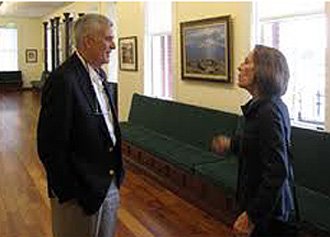
John Canemaker chats with Diane Disney Miller during his
recent visit to the Walt Disney Family Museum
During a round-table interview, Diane was asked about "Fantasia" and where it ranks among her father's classic films.
"It has to be right up there because of the music, the effects, the animation," she said.
"It stands apart," Walter added. "It's so different, so unique."
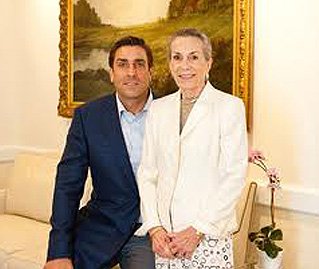
Walter Elias Disney Miller and Diane Disney Miller
In a detailed commentary track accompanying "Fantasia," Disney historian Brian Sibley says: "I know of no other motion picture that takes you on quite such an astonishing and stimulating voyage of visual and aural exploration. Walt Disney's 'Fantasia,' is a film that remains as challenging and rewarding as when it was first created more than 70 years ago."
While the focus of the press event was "Fantasia / Fantasia 2000," the questions quickly turned to the museum.
Diane explained how the idea for a museum grew out of the family-financed documentary film, "Walt – The Man Behind the Myth," a CD-rom project, "Walt Disney: An Intimate History of the Man And His Magic. Windows CD-ROM.," and an online "museum" dedicated to Walt Disney's life story. The family had been leasing warehouse / office space at The Presidio filled with Walt's numerous awards, his massive miniature collection, the Lilly Belle, a few paintings and other personal possessions. There really wasn't much in the way of animation art or maquettes, because Walt "didn't bring those things home," but there were still several treasures worth sharing with the world.
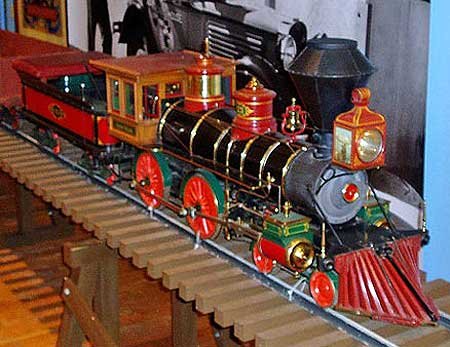
The Lilly Belle
Diane also thought that her father had been trashed in some biographies, including "Walt Disney: Hollywood's Dark Prince," and "Walt Disney: The Triumph of the American Imagination." Those books didn't reflect the man she knew and loved dearly or the warm relationship between Walt and his wife, Lillian.
"But why San Francisco?"
It's a question Walt's daughter heard many times that day and one that I've heard from several Disney enthusiasts since even before the museum opened on Oct. 1, 2009.

Diane Disney Miller cuts the ribbon at the Walt Disney Family Museum
on October 1, 2009
Diane explained that the family had considered several locations for the museum, including near Griffith Park, the Walt Disney Concert Hall or the Autry National Center in Los Angeles as well as a site in Kansas City. The family even considered Napa, where she lives with her husband, Ron Miller, a former Disney CEO.
Eventually, the Presidio Trust approached the Walt Disney Family Foundation after deciding to make the former barracks buildings available for lease. LucasFilm is located at The Presidio; DreamWorks has a production facility near the San Francisco Airport and Pixar is located across the bay in Emeryville.
The family looked at the beautiful brick structure and the view it offered of the iconic Golden Gate Bridge. They saw its potential and were hooked.
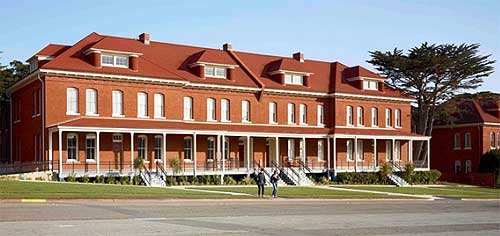
The Walt Disney Family Museum at San Francisco's Presidio
Diane said, "Why not San Francisco?"
She also believed it was in her dad's "spirit to renovate an old building" and outfit it with cutting-edge technology to let him and his colleagues tell the story of his life.
There are some Disney ties to the city by the bay, although they're rarely mentioned: San Francisco's Courvoisier Gallery was the first to recognize animation cels as popular art. The Disney Studios was a longtime client of San Francisco-based Bank of America and museum visitors can listen to a few audio clips of Walt's brother, Roy O. Disney, talking about the studio's relationship with its bankers. Walt Disney's lifelong friendship with Art Linkletter was launched when the two met during a "Fantasia" event in San Francisco. Walt Disney received the Key to San Francisco in 1958, prominently displayed with the many Oscars and other awards in the museum's foyer.
And, arguably, San Francisco is a stronger international tourist destination than Los Angeles. Remember, Walt's influence was global.
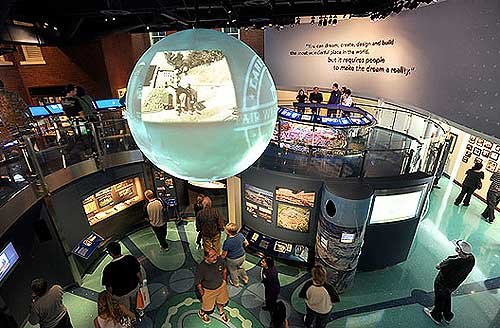
The "1950s & 1960s: The Big Screen and Beyond" gallery at the Walt Disney Family Museum
Most everyone thought if you build it and it has the name Walt Disney attached to it, people will come. They are coming, but not in the numbers really needed for the museum to thrive.
I talked to Walter about some of the challenges the museum has faced, especially in regards to marketing. I've visited several times when the galleries are nearly deserted, although attendance picks up during the holidays as locals take out-of-town guests to visit the museum or to see "Christmas with Walt Disney," an hour-long film worth catching. Judge the relationship Walt and Lillian had based on the footage shown here as well as what's featured in "Walt & El Grupo."
Marketing is trying. There have been print ads and stories in several newspapers across the country, including New York and Los Angeles. There are banners up at various locations in San Francisco and some advertising with San Francisco MUNI. An award-winning "Eye on the Bay" evening TV magazine episode on the museum featuring Walt's daughter and John Lasseter has aired several times and there was a great segment on the nationally broadcast CBS' "Sunday Morning" shown when the museum first opened. D23 has included a few stories in the pages of its luxurious magazine.

(L to R) Diane Disney Miller, John Lasseter and Nancy
Lasseter at the Walt Disney Family Museum's
opening gala
One thing few people realize is that in 1982, long before there was any thought of opening a museum dedicated to Walt Disney, Lillian and daughters, Diane and Sharon, sold the company the rights to Walt Disney's name and likeness in deal that included the Disneyland Railroad and Monorail.
That means the museum must get company approval for its marketing and advertising campaigns. Items in the museum's store featuring Walt's name and likeness or any animated character have to be cleared. Even sponsors have to be OK'd by the company. The website, www.waltdisney.org, is hosted by the company and is updated only once a month.
To improve the timeliness of its communications, the museum launched a blog, Storyboard, and it recently held a fan-based contest to create a YouTube video to help with marketing. A winner will be selected soon.
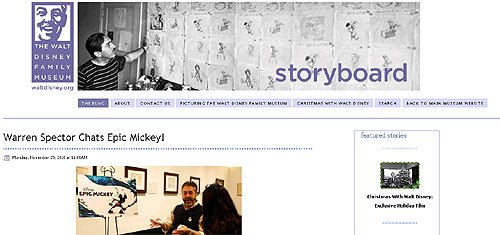
Storyboard, the Walt Disney Family Museum's new blog
The relationship with the company is good, as the "Fantasia / Fantasia 2000" press event indicates. Still, even good relationships can be improved.
The Presidio Trust has also made things a bit more challenging with its restrictions on signage. Despite adding a massive glass wall and in-fill gallery to turn a U-shaped building into a rectangle because – in theory – the in-fill gallery could later be removed, the Presidio Trust will not allow the museum to install any semi-permanent signage or even a "Partners-like" sculpture. A couple of banners are put over the handrails and fold-out signs are set up on the sidewalk in front of the museum and removed daily.
There's ample free parking for the museum, a rare thing in San Francisco, although plans call for a great lawn to eventually replace the huge parking lot. Some visitors who take a taxi to the museum have had trouble getting service out of The Presidio.
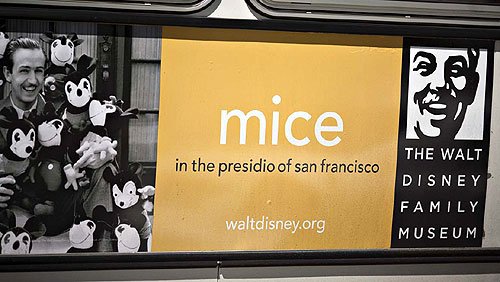
One of the bus signs that are now rolling around San Francisco, promoting
the Walt Disney Family Museum
A few special promotions, including one tied to the World Series and the San Francisco Giants was a big hit, offering discounted admissions to anyone sporting a Giants hat or shirt. A Toys for Tots promotion is planned, but no details have been released.
The admission price of $20 for adults; $15 for students and seniors; and $12 for children 6 to 17, may seem pricey to some given the Bay Area's battered economy, but there are few complaints after people experience the galleries.
Those who've visited – even casual fans – walk away with a deeper understanding and appreciation of the man who launched a little cartoon studio with his older brother, Roy, and continued to grow and diversify the family business.

Lillian & Walt Disney receive the Key to the City from San Francisco Mayor George
Christopher and his wife in December of 1958. Image courtesy
of the Walt Disney Family Museum
"The reaction and word of mouth has been well beyond our expectations," Walter said. "We hope to utilize more of it in our marketing."
Stories written by those attending the "Fantasia / Fantasia 2000" press event and the bonus material in the Blu-ray / DVD releases will help. Walter said the short segment on the museum – or at least part of it – will soon be broadcast to rooms at The Disneyland Resort with hopes that it will eventually be shown on the ships of the Disney Cruise Line and the company-owned resorts in Florida.
Events
From toxic gas leaks to the triumph of ‘Finding Dory,’ Lindsey Collins has loved every minute of her time at Pixar Animation Studios

When it comes to “Finding Dory” producer Lindsey Collins, she takes “going-with-your-gut” to a whole new level.
To explain: This Occidental College graduate joined Walt Disney Animation Studios straight out of school in 1994. And after working as a PA on “Pocahontas” & “The Hunchback of Notre Dame,” Lindsey had just been made assistant production manager on “Hercules” when she began hearing people talk about Pixar.
“I was working at Disney with Ron & John (Author’s note: That’s Ron Clements & John Musker, the acclaimed animation directing team behind not only “Hercules” but also “The Little Mermaid,” “Aladdin” and WDAS’ soon-to-be-released “Moana”) and was really enjoying that experience. But just before ‘Toy Story’ came out, there was a brief blurb in the company newsletter about Pixar. And I was like ‘Well, who are these guys?’ And then I got to meet John Lasseter and was just totally blown away by what he and his team were doing,” Collins recalled during a recent phone interview.
 Lindsey Collins. Copyright Disney Pixar
Lindsey Collins. Copyright Disney Pixar
“Anyway, Disney liked what I was doing at Feature Animation and really wanted me to stay on there. So they offered me a contract. And I was like ‘I’m fine. I can stay here.’ So I signed that contract. And then I went home and threw up all night,” Lindsey laughed. “The very next day, I went back into Disney and said ‘I’m sorry. I can’t do this. I really have to go.’ Then I went up to the Bay area and basically pounded on Pixar’s door & said ‘please, please, please hire me.’ “
Luckily for Ms. Collins, Pixar Animation Studios was just in the process of gearing up to do “A Bug’s Life.” More to the point, Sharon Calahan – the director of photography on that production – saw lots of potential in this recent Mouse House escapee.
“Sharon was hugely involved with Pixar’s decision to hire me. And part of that was because I had worked with background painters while I was at Disney Feature Animation. So even though I had no clue how CG worked at that time, I could talk with Sharon in the terms of painting. And she was like ‘That’s exactly how I want people around here to start thinking when it comes to how we light our scenes,’ ” Collins continued.
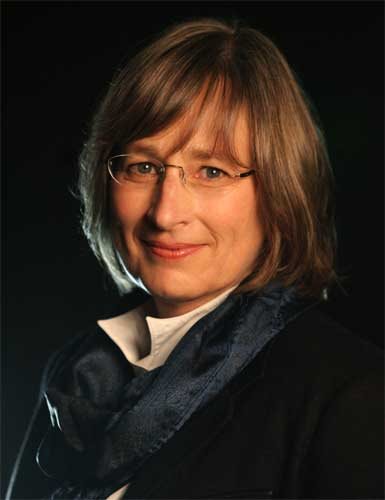 Sharon Calahan. Copyright Disney Pixar
Sharon Calahan. Copyright Disney Pixar
“Mind you, I was the one who kept telling Sharon ‘I don’t know how helpful I can be to you guys. Because I really don’t understand a lot of what you’re saying when it comes to CG.’ But she wouldn’t give up on me. Sharon kept insisting that – because I had already worked with artists and knew how to communicate a vision for a painting – I was also going to be able to communicate with software engineers. It was just a matter of learning a new language. Sharon was instrumental in convincing me that I had any right to be at Pixar,” Lindsey stated.
Which isn’t to say that life was initially easy for Collins at Pixar. First there was that steep learning curve which came with her new job (“When I first got here, I had no idea what a render farm was. I was like ‘There’s a farm? Like a petting zoo?’ “). Then there was the fact that the Port Richmond office park which housed this animation studio at that time was downwind of a Chevron plant (“Sometimes – because there’d be explosions or gas leaks at that plant — we’d then be told to shelter in place or to not come into work at all that day. We used to call those toxic snow days”).
But even under these somewhat stressful & occasionally toxic conditions, Lindsey thrived. Largely because she really loved her new co-workers at Pixar (“They were people who could really make me laugh. In a way I didn’t know that real adults / professionals could make me laugh. And I feel like I haven’t stopped since I got here”).
 Copyright Disney Pixar
Copyright Disney Pixar
But it hasn’t all been big laughs. Take – for example – what happened when Ed Catmull, the president of Pixar Animation Studios, approached Collins (who was producing “Finding Dory” at that time) about a change that he wanted to make to that Andrew Stanton film.
“Pixar had this new renderer that it wanted to try out. And Ed felt ‘Dory’ would be the perfect project to try this new technology on. The only problem was that – when Ed approached me – we were already well into production on this ‘Finding Nemo’ sequel. Which meant – if we were going to take full advantage of what Ed was offering us – we’d then have go back and redo a bunch of stuff we’d already done on this movie,” Lindsey said.
“But the good news was – because “Dory” was a sequel to “Nemo” – we weren’t discovering a look for this movie. We were just trying to improve on it,” Collins continued. “And that was the handshake deal that Ed was offering. That – if we agreed to use this new renderer plus some new lighting & shading tools. Basically reinventing the entire back end of the Pixar production line – we’d then end up with a far better looking film that was still set in the same world as ‘Nemo.’ As long as the studio delivered on that promise, Andrew was willing to go for it. Mind you, it would be another full year before Andrew would then actually get to see any footage that this new renderer produced. So it was a huge leap-of-faith on his part. But Andrew was incredibly excited when the redone ‘Dory’ footage began coming in and it all looked so great.”
 Copyright Disney Pixar
Copyright Disney Pixar
Another technology challenge that Lindsey had to deal with while producing this “Finding Nemo” sequel was Hank the septopus. But in this case, as soon as Collins saw this character described in an early draft of Stanton’s ‘Dory’ script, she immediately got Pixar’s character department involved.
“When you’re working as a producer, you get to see pages a lot earlier than the rest of the crew. And as soon as I read that first scene with Hank, I turned to Andrew and said ‘Just how big a character are we talking here?’ And he said ‘I think it’s a pretty big role.’ And I was like ‘Okay.’ And I then went down to the character department and told them that Andrew wanted to add an octopus to the cast. And they all went kind of pale,” Lindsey said. “I think what they knew right-off-the-bat that – if we were going to do an octopus in the ‘Nemo’ / ‘Dory’ world with all of the realism & beauty that entails and then have that character fit in – it was going to be incredibly difficult if not kind of impossible to pull that off. Largely because the character of Hank couldn’t be super-cartoony.”
“I mean, on ‘Finding Nemo,’ we had had Pearl, the little octopus who was in Mr. Ray’s class. But clearly the whole point of a character like Hank was that he needed to be a jack-of-all-trades. That this character was going to have to be able to get in & out of everything. So the character department knew – right off the bat – that this was going to be something that would kind of break the bank, if you will,” Collins continued.
 Copyright Disney Pixar
Copyright Disney Pixar
“Now what you have to understand about Pixar is that we play ‘Chicken’ a lot here. By that I mean, we see how long we can let something sit on the page before we then have to finally move it into production. But when it came to Hank, that just wasn’t an option,” Lindsey stated. “Based on this character’s needs, Hank was going to take every minute we had, all the time between when he first appeared in Andrew’s script and when we’d be in full production on ‘Dory’ to build this. So we needed to commit very early on this character. But the good news is that I think we bet right on Hank. He actually wound up being a far bigger character in this film. And I think that was partially because the technology which drove this character was so cool.”
So how did it feel – after five years of hard work – to have “Finding Dory” become this hugely popular motion picture? The fifth animated film in all of Hollywood history to earn over a billion dollars at the worldwide box office? Collins – the mother of three – put a somewhat maternal spin on her reply.
“You have to understand that – when you work on projects like ‘Dory’ or ‘John Carter’ for as long as Andrew and I did – these movies are kind of like your kids. In that they then go off & have their own successes & failures which are kind of beyond your control as a parent,” Lindsey said. “But as you’re finishing up working on a film, emotions do sometimes well up at the weirdest time.”
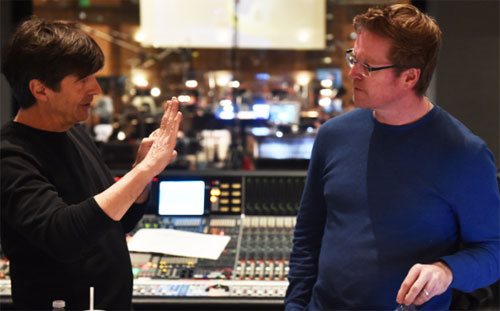 Thomas Newman (L) and Andrew Stanton in the booth during the recording sessions for “Finding Dory” ‘s score. Copyright Disney Pixar
Thomas Newman (L) and Andrew Stanton in the booth during the recording sessions for “Finding Dory” ‘s score. Copyright Disney Pixar
Take – for example – what happened while Collins & Stanton were sitting in the recording booth as Thomas Newman rode herd on “Finding Dory” ‘s scoring sessions.
“We’d had this huge orchestra for four days. And then – on the last day – Tom cleared the stage and recorded the scene where Nemo, Marlin & Dory reunite in the pipes under the Marine Life Center. Now you have to understand that this is one of the only times in his score for ‘Finding Dory’ that Tom reprises a cue from “Finding Nemo.’ And he has this single clarinet – or was it an oboe? – play that cue,” Lindsey recalled. “And as this was happening, Andrew got really quiet. He was just sitting there, watching.”
“So I went up to him and said ‘What’s going on? How are you feeling about all this?’ Because we were finishing this film up at that time. And Andrew looked at me and he was really emotional. And then he said “I remember the first time I wrote Dory’s name on a piece of paper. I can’t believe how far she’s come.’ And that’s when I started getting emotional too, ” Collins said.
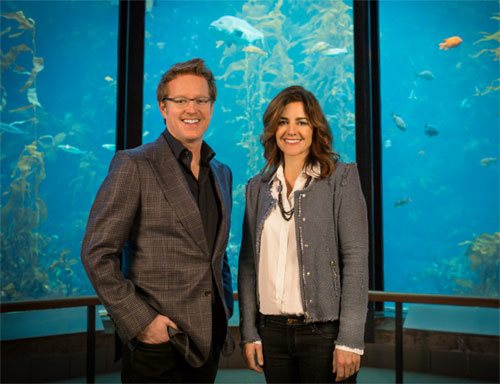 Andrew Stanton & Lindsey Collins. Copyright Disney Pixar
Andrew Stanton & Lindsey Collins. Copyright Disney Pixar
And speaking of ” … how far she’s come,” one might say the same thing about Lindsey. Who – it should be noted here – when she was studying at Occidental College 25 years ago, didn’t major in business or film studies. But – rather – diplomacy and world affairs.
“Those diplomacy skills do actually come in handy when you’re working on a movie. But you want to honestly know the very best thing you can do at college if you eventually hope to become a producer? Work as an RA,” Collins concluded. “Katherine Sarafian – who’s also a producer here at Pixar — also ran a dorm while she was in college. And the two of us agree that that job was great training for becoming a producer. When you’re constantly dealing with people and have to get answers to ridiculous questions like ‘Okay, who pooped in the closet?’ “
The Blu-ray & DVD version of Pixar’s “Finding Dory” hits store shelves today.
This article was originally published by the Huffington Post on Tuesday, November 15, 2016
Events
Women in Animation panels prove that there’s more to San Diego Comic-Con than just promotion of pop culture
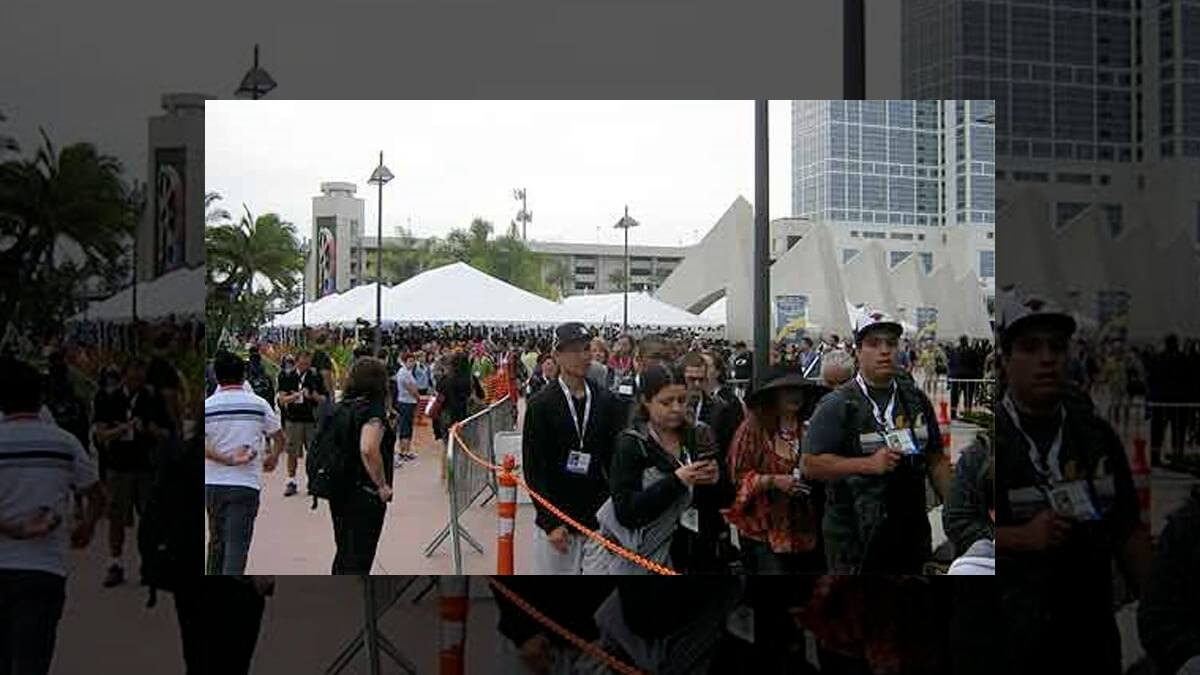
Thanks to Comic-Con International, now through Sunday, San
Diego is the white-hot center of the pop culture universe.

Photo by Jim Hill
Mind you, there’s more to this four day-long event than
those high-profile presentations in Hall H. Which is where various movie
studios will be parading celebrities & showing exclusive clips. All with
the hope that those 6000 early adopters who have (some of them, anyway) been
camped out in this cavernous convention center for hours ahead of time will
then hop on social media and start evangelizing about how cool that footage
from next summer’s would-be blockbuster looked.
But if you can look past those long lines for
limited-edition merchandise and/or the tens of thousands of people who are
cosplaying, you’ll see that there’s another, more serious side to Comic-Con
International. And that’s the part of this four day-long event which allows a lot
of creatives to reconnect with one another.
Take – for example – Marge Dean, the general manager of
Stoopid Buddy Stoodios (i.e., that Burbank-based operation which is responsible
for “Robot Chicken,” television’s longest-running stop motion series, as well
as Sony’s just-about-to-begin-production-on-its-second-season-for-Crackle
superhero spoof, “SuperMansion”). Over the past decade, she’s made at least
eight trips down to San Diego for Comic-Con International. And what Marge loves
most about this four day-long event is all of the old friends she invariably
runs into as she’s coming & going from the convention center.

Photo by Jim Hill
“Whenever I’m down in San Diego for Comic-Con, I just love
the experience of getting outside the hall, walking down the street and then
suddenly going ‘It’s you ! A guy I haven’t seen in three years ! How are you
!,” Dean recalled during a recent phone interview. “Even though I really don’t
like driving to Comic-Con – which is why, these days, I always take the train
down from LA – I really enjoy strolling around San Diego and then running into
people that I haven’t seen for a long, long time.”
Mind you, Marge is sure to run into a lot of people that she
knows / has previously worked with today in Room 24ABC at the San Diego
Convention Center. That’s because this is where Comic-Con’s “Cartoon Creatives:
Women Power in Animation” panel will be held starting at 4:30 p.m. PT. And
joining Dean at this gathering (which will be shining a spotlight on Women in
Animation‘s goal to have a 50/50 workforce by 2025) will be a veritable who’s
who from the worlds of television & feature animation.
Among those who are scheduled to appear today are:

Daron Nefcy, the creator / executive producer of “Star vs. the Forces of Evil.”
Copyright Disney Enterprises, Inc. All rights reserved
-
Lauren Faust (the creator of “My Little Pony:
Friendship is Magic”) -
Brooke Keesling (the director of animation
talent development at Disney TV Animation) -
Katie Krentz (the senior director of development
at Cartoon Network) -
Lauren Montgomery (the co-executive producer of
“Voltron: Legendary Defender”) -
Daron Nefcy (the creator / executive producer of
“Star vs. the Forces of Evil”) -
Gina Shay (the producer of DreamWorks
Animation’s “Trolls”) -
Stevie Wermers-Skelton (the co-director of
Disney’s upcoming “Frozen” holiday special)
Dean (who serves as the co-president of WIA) views this
hour-long session (which will be moderated by Leslie Combemale of Animation
Scoop) as a great example of a lesser known aspect of Comic-Con International.
Which is the many ways that this four day-long event educates the fan
community. Gives them a clearer understanding of what’s really going on in
today’s entertainment world.

Marge Dean, co-president of Women in Animation, speaking at a WIA event
honoring Nickelodeon’s contributions to television animation.
“I mean, did you know that women hold only 20% of the
creative roles in today’s animation industry? While the landscape has obviously
changed over the 20+ years that I’ve worked in this field, women still predominantly
work on the management side of animation. Not the creative end of things,”
Marge continued. “That’s a big part of what the Women in Animation organization
is all about. More to the point, why we’re doing outreach to the fan community
at Comic-Con this week. We’re looking to shine a spotlight on this disparity in
the industry and hopefully create some opportunities for more women to break
through creatively in the future.”
Of course, in order to know where you are (more importantly,
where you’re headed next), it helps to have to have a firm understanding of
where you’ve been. Which is why WIA will be holding a second panel at Comic-Con
International, “She Made That? Nickelodeon hosts Women in Animation.” This
presentation (which will also be held in Room 24ABC from 6:30 – 7:30 p.m. PT on
Friday, July 22nd) will honor some of the real pioneers of
television animation. The women who helped create such memorable Nicktoon
series as:
-
Vanessa Coffey (“The Ren & Stimpy Show,”
“Rugrats” & “Doug”) - Mary Harrington (“Invader Zim,” “Hey Arnold!”)
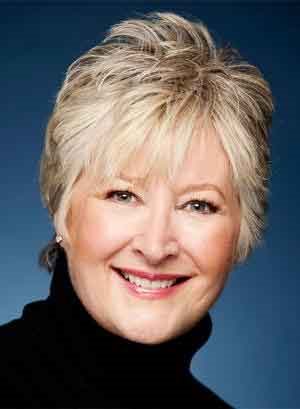
Television animation pioneer Margaret Loesch
Of course, Coffey was quick to credit the woman who gave her
a leg up when she was just getting her start in animation in the early 1980s.
And that was Margaret Loesch, the then-President and CEO of Marvel Productions.
“At that time, Margaret was the only woman working in
television animation. I was just this intern, working down the hall from Stan
Lee. But Margaret took a chance on me,” Vanessa remembered. “And Margaret not
only mentored me, she genuinely inspired me. I mean, here she was running this
huge production company in a field that was mostly run by men. Margaret proved to
me that not only should women in the animation business but that they could be
these huge successes.”
You see? That’s what’s really great about Comic-Con
International. If you can just get past all of the hype (not to mention handle those
super-crowded conditions you’ll encounter out on the show floor), you might
then discover that some real education has been mixed in with your
entertainment.

(L to R) Vanessa Coffey, Stephen
Hillenburg (the creator of
“SpongeBob SquarePants”) and and Butch Hartman (the
creator of “The Fairly Oddparents.”
Comic-Con International is running at the San Diego
Convention Center now through Sunday, July 24th.
This article was originally posted on the Huffington Post’s Entertainment page on Thursday, July 21, 2016.
Books & Print
It’s Jim Hill in the Restaurant with the Book – The Jungle Book – and You Can Join Him June 5th
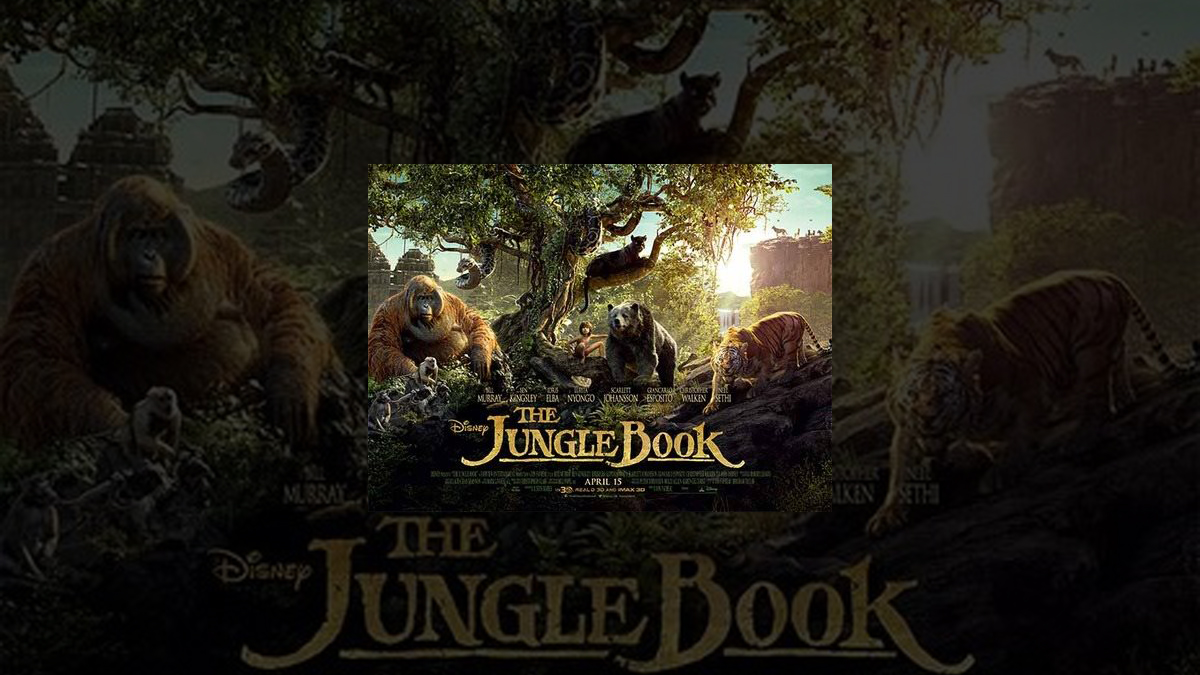
It’s a Jungle (Book) Out There

For more than 50 years, The Walt Disney Company has been reimagining the writings of Rudyard Kipling–taking his tales of Mowgli the man-cub and his animal friends and then turning them into hugely popular films and television series.

Let Jim Hill take you from Bill Peet’s far-too-dark take on this tale (which Walt Disney just hated) to Jon Favreau’s photo-realistic box office smash (for which the Studio is already developing a sequel).
You’re sure to go ape as you listen to all of these great behind-the-scenes show business stories.
Join us June 5th, 2016 from 11:30 AM-1:30 PM at HB Burger, 127 West 43rd Street in New York City
Tickets are $62.00: Each ticket includes lunch at HB Burger, the program, and a special souvenir.
Buy tickets now on line here –> Unofficial Guide’s Disney Dish site or here –> e.t.c. (events — tailor made & customized)
Get your tickets now!
email events@etccustomevents.com with any additional questions.
-

 Film & Movies7 months ago
Film & Movies7 months agoBefore He Was 626: The Surprisingly Dark Origins of Disney’s Stitch
-

 History5 months ago
History5 months agoCalifornia Misadventure
-

 History10 months ago
History10 months agoThe Super Bowl & Disney: The Untold Story Behind ‘I’m Going to Disneyland!’
-

 Television & Shows11 months ago
Television & Shows11 months agoHow the Creators of South Park Tricked A-List Celebrities to Roast Universal – “Your Studio & You”
-

 Film & Movies6 months ago
Film & Movies6 months agoThe Best Disney Animation Film Never Made – “Chanticleer”
-

 Theme Parks & Themed Entertainment5 months ago
Theme Parks & Themed Entertainment5 months agoThe ExtraTERRORestrial Files
-

 History6 months ago
History6 months agoWhy Disney’s Animal Kingdom’s Beastly Kingdom Was Never Built
-

 Television & Shows7 months ago
Television & Shows7 months agoThe Untold Story of Super Soap Weekend at Disney-MGM Studios: How Daytime TV Took Over the Parks






